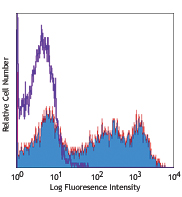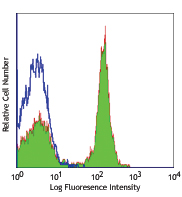- Clone
- RMA-1 (See other available formats)
- Regulatory Status
- RUO
- Other Names
- Immunoglobulin A
- Isotype
- Rat IgG1, κ
- Ave. Rating
- Submit a Review
- Product Citations
- publications
| Cat # | Size | Price | Quantity Check Availability | Save | ||
|---|---|---|---|---|---|---|
| 407003 | 50 µg | 67€ | ||||
| 407004 | 500 µg | 165€ | ||||
The RMA-1 monoclonal antibody reacts with immunoglobulin A (IgA) in all tested mouse haplotype (Igh-a and b). It does not react with other isotypes. The RMA-1 monoclonal antibody may be used as primary or secondary reagent for ELISA or immunofluorescent analysis.
Product DetailsProduct Details
- Reactivity
- Mouse
- Antibody Type
- Monoclonal
- Host Species
- Rat
- Immunogen
- Mouse Ig cocktail
- Formulation
- Phosphate-buffered solution, pH 7.2, containing 0.09% sodium azide.
- Preparation
- The antibody was purified by affinity chromatography, and conjugated with biotin under optimal conditions.
- Concentration
- 0.5 mg/ml
- Storage & Handling
- The antibody solution should be stored undiluted between 2°C and 8°C. Do not freeze.
- Application
-
ELISA - Quality tested
FC - Verified - Recommended Usage
-
Each lot of this antibody is quality control tested by ELISA method. This biotinylated Rat anti-Mouse IgA antibody (Cat. No. 407003) was used as the detection antibody at working concentration 0.5 µg/mL with the capture antibody (Cat. No. 405301) to detect Mouse anti-CD19 IgA. It is recommended that the reagent be titrated for optimal performance for each application.
-
Application References
(PubMed link indicates BioLegend citation) -
- Lee EH, et al. 2013. J Ethnopharmacol. 146:608. PubMed.
- Product Citations
- RRID
-
AB_315078 (BioLegend Cat. No. 407003)
AB_315079 (BioLegend Cat. No. 407004)
Related FAQs
- How many biotin molecules are per antibody structure?
- We don't routinely measure the number of biotins with our antibody products but the number of biotin molecules range from 3-6 molecules per antibody.
Customers Also Purchased



Compare Data Across All Formats
This data display is provided for general comparisons between formats.
Your actual data may vary due to variations in samples, target cells, instruments and their settings, staining conditions, and other factors.
If you need assistance with selecting the best format contact our expert technical support team.
 Login / Register
Login / Register 










Follow Us